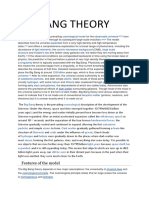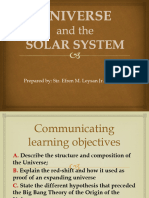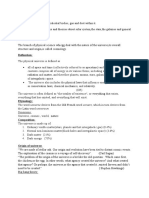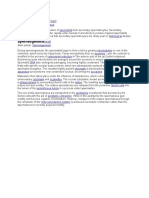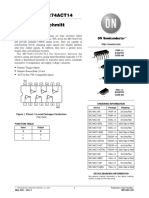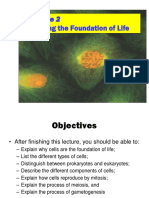Astronomers Discovered Stars in The Galaxy That Are Almost 13.6 Billion Years Old
Astronomers Discovered Stars in The Galaxy That Are Almost 13.6 Billion Years Old
Uploaded by
Garcia AzirCopyright:
Available Formats
Astronomers Discovered Stars in The Galaxy That Are Almost 13.6 Billion Years Old
Astronomers Discovered Stars in The Galaxy That Are Almost 13.6 Billion Years Old
Uploaded by
Garcia AzirOriginal Title
Copyright
Available Formats
Share this document
Did you find this document useful?
Is this content inappropriate?
Copyright:
Available Formats
Astronomers Discovered Stars in The Galaxy That Are Almost 13.6 Billion Years Old
Astronomers Discovered Stars in The Galaxy That Are Almost 13.6 Billion Years Old
Uploaded by
Garcia AzirCopyright:
Available Formats
Astronomers calculate the age of the universe by assuming that the Lambda-CDM model accurately
describes the evolution of the Universe from a very uniform, hot, dense primordial state to its present
state and measuring the cosmological parameters which constitute the model. [citation needed] This model is
well understood theoretically and supported by recent high-precision astronomical observations such
as WMAP and Planck.[citation needed] Commonly, the set of observations fitted includes the cosmic
microwave background anisotropy, the brightness/redshift relation for Type Ia supernovae, and
large-scale galaxy clustering including the baryon acoustic oscillation feature.[citation needed] Other
observations, such as the Hubble constant, the abundance of galaxy clusters, weak gravitational
lensing and globular cluster ages, are generally consistent with these, providing a check of the
model, but are less accurately measured at present. [citation needed] Assuming that the Lambda-CDM model
is correct, the measurements of the parameters using a variety of techniques by numerous
experiments yield a best value of the age of the universe as of 2015 of 13.799 ± 0.021 billion years.[2]
Astronomers discovered stars in the Milky Way galaxy that are almost 13.6 billion years old.
Over time, the universe and its contents have evolved; for example, the relative population
of quasars and galaxies has changed[62] and space itself has expanded. Due to this expansion,
scientists on Earth can observe the light from a galaxy 30 billion light-years away even though that
light has traveled for only 13 billion years; the very space between them has expanded. This
expansion is consistent with the observation that the light from distant galaxies has been redshifted;
the photons emitted have been stretched to longer wavelengths and lower frequency during their
journey. Analyses of Type Ia supernovae indicate that the spatial expansion is accelerating.[63][64]
The more matter there is in the universe, the stronger the mutual gravitational pull of the matter. If
the universe were too dense then it would re-collapse into a gravitational singularity. However, if the
universe contained too little matter then the self-gravity would be too weak for astronomical
structures, like galaxies or planets, to form. Since the Big Bang, the universe has
expanded monotonically. Perhaps unsurprisingly, our universe has just the right mass-energy
density, equivalent to about 5 protons per cubic metre, which has allowed it to expand for the last
13.8 billion years, giving time to form the universe as observed today. [65]
You might also like
- Article Universe 6 212 12 After Joseph 7 10 12Document10 pagesArticle Universe 6 212 12 After Joseph 7 10 12Alexander BolonkinNo ratings yet
- Observable UniverseDocument16 pagesObservable UniverseRohithNo ratings yet
- UniverseDocument2 pagesUniverseapi-3781793No ratings yet
- Accelerating Expansion of The UniverseDocument18 pagesAccelerating Expansion of The Universesipobey750No ratings yet
- History: Cosmos World NatureDocument27 pagesHistory: Cosmos World NatureAjitesh TrehanNo ratings yet
- What Is Dark Energy?Document20 pagesWhat Is Dark Energy?Harsh DhyaniNo ratings yet
- Ramir BatongbakalDocument13 pagesRamir Batongbakalramir batongbakalNo ratings yet
- Aviral Srivasatava (5511) Age and Nature of The UniverseDocument5 pagesAviral Srivasatava (5511) Age and Nature of The UniverseAviral SrivastavaNo ratings yet
- 2023-24 MYP4 Phy U4 AP Resources-Part ONEDocument40 pages2023-24 MYP4 Phy U4 AP Resources-Part ONEtushant.avudurthiNo ratings yet
- The New Economy Model Universe: ForewordDocument6 pagesThe New Economy Model Universe: ForewordSrinivas SaiNo ratings yet
- The UniverseDocument10 pagesThe UniverseAaron YogurtNo ratings yet
- Big Bang Theory jhuytttttttttttttttttttttttttttttttttttttttttttttttttttttttttttttttttttttttttttttttffffffffffffffffffffffffffffffxxxxxxxxxxxxxxxxxxxxxxxxxxxxxxxbbbbbbbbbbbbbbbbbbbbbdssssssssssssssssssssdmjkgfffffffffffffffffDocument32 pagesBig Bang Theory jhuytttttttttttttttttttttttttttttttttttttttttttttttttttttttttttttttttttttttttttttttffffffffffffffffffffffffffffffxxxxxxxxxxxxxxxxxxxxxxxxxxxxxxxbbbbbbbbbbbbbbbbbbbbbdssssssssssssssssssssdmjkgfffffffffffffffffSwaraj PandaNo ratings yet
- The Expanding UniverseDocument3 pagesThe Expanding UniverseMary Francia RicoNo ratings yet
- CHAPTER 3 Hubbles LawDocument8 pagesCHAPTER 3 Hubbles Lawabishek981021No ratings yet
- The UniverseDocument12 pagesThe UniverseŚáńtőśh MőkáśhíNo ratings yet
- The UniverseDocument11 pagesThe UniverseAaron YogurtNo ratings yet
- Big Bang TheoryDocument3 pagesBig Bang Theoryaruni mancheyNo ratings yet
- Theory BigBangDocument20 pagesTheory BigBanghermanNo ratings yet
- Baryon Acoustic OscillationsDocument8 pagesBaryon Acoustic OscillationsMacbeth HollidayNo ratings yet
- Bellido. .Astrophysics.&.CosmologyDocument78 pagesBellido. .Astrophysics.&.CosmologyMohamed RjiliNo ratings yet
- Tools of AstronomyDocument14 pagesTools of AstronomyHritaban SarkarNo ratings yet
- Origin of The UniverseDocument31 pagesOrigin of The UniverseIver ArciagaNo ratings yet
- Astrophysics Assignment 3Document10 pagesAstrophysics Assignment 3Anuj KansaraNo ratings yet
- Galaxies: Genesis and EvolutionDocument7 pagesGalaxies: Genesis and EvolutionAmajiki TamakiNo ratings yet
- Future of An Expanding UniverseDocument23 pagesFuture of An Expanding Universesipobey750No ratings yet
- Twin ParadoxesDocument19 pagesTwin ParadoxesSurya PrakashNo ratings yet
- The Standard Model of CosmologyDocument45 pagesThe Standard Model of CosmologyKaren VillaNo ratings yet
- Trigonometric Distance and Proper MotionDocument14 pagesTrigonometric Distance and Proper MotionGadhadar ReddyNo ratings yet
- Dark MatterDocument22 pagesDark MattermCmAlNo ratings yet
- New Perspectives in Astrophysical Cosmology: Second EditionDocument23 pagesNew Perspectives in Astrophysical Cosmology: Second Editionme-elormNo ratings yet
- Astrophysics and CosmologyDocument78 pagesAstrophysics and Cosmologydrjoaom9225No ratings yet
- CRSQ Summer 2012 SamecDocument14 pagesCRSQ Summer 2012 SamechayeswNo ratings yet
- Cosmic Findings of Wmap-2003Document1 pageCosmic Findings of Wmap-2003Armina KafedzicNo ratings yet
- Trumpler 1930Document14 pagesTrumpler 1930macchialowNo ratings yet
- The Universe - CK-12 FoundationDocument13 pagesThe Universe - CK-12 FoundationKenyNo ratings yet
- D3 - CosmologyDocument25 pagesD3 - Cosmologyraghava vadhiyarNo ratings yet
- Evidence For Anisotropy of Cosmic Acceleration: Letter To The EditorDocument7 pagesEvidence For Anisotropy of Cosmic Acceleration: Letter To The EditorgabrielfbarrozoNo ratings yet
- Universe - WikipediaDocument19 pagesUniverse - WikipediaTejasNo ratings yet
- A Fundamental Test For Physics: The Galactic Supermassive Obscure BodiesDocument7 pagesA Fundamental Test For Physics: The Galactic Supermassive Obscure BodiesgeorgerouseNo ratings yet
- Observable UniverseDocument11 pagesObservable Universeshirishkpatil1159No ratings yet
- Chapter 3 Lecture NotesDocument59 pagesChapter 3 Lecture Notesmivel70575No ratings yet
- Earth and The Solar SystemDocument8 pagesEarth and The Solar System2t9jt87dv7No ratings yet
- UNIVERSEDocument21 pagesUNIVERSEwaji khan100% (1)
- Stefano Borgani and Andrey Kravtsov - Cosmological Simulations of Galaxy ClustersDocument46 pagesStefano Borgani and Andrey Kravtsov - Cosmological Simulations of Galaxy ClustersPogz1995No ratings yet
- Galaxy Rotation Curve - WikipediaDocument51 pagesGalaxy Rotation Curve - WikipediaMUHAMMAD ARSLANNo ratings yet
- Large Scale Structure of The UniverseDocument9 pagesLarge Scale Structure of The UniverseShivan Maharaj0% (1)
- The Cosmic Microwave BackgroundDocument2 pagesThe Cosmic Microwave BackgroundEric PierceNo ratings yet
- CHAPTER 6 RedshiftDocument3 pagesCHAPTER 6 Redshiftabishek981021No ratings yet
- CMB Fluctuations _ IBDP Physics HL FE2016 _ Kognity- Part 5 -2Document7 pagesCMB Fluctuations _ IBDP Physics HL FE2016 _ Kognity- Part 5 -2onur yavuzcetinNo ratings yet
- Note - Earth&UniverseDocument12 pagesNote - Earth&UniversenayemNo ratings yet
- UniverseDocument3 pagesUniverseSharmila AbieraNo ratings yet
- The Qur'an On Cosmology - Part TwoDocument49 pagesThe Qur'an On Cosmology - Part Twosamiur rahmanNo ratings yet
- Chapter 4-Extra-Solar Planets - 4.1-4.3 - Buctuan-DensingDocument41 pagesChapter 4-Extra-Solar Planets - 4.1-4.3 - Buctuan-DensingLeigh DensingNo ratings yet
- Unit 6Document24 pagesUnit 6Ajwa AachiNo ratings yet
- Space: (Spectroscopic All-Sky Cosmic Explorer)Document17 pagesSpace: (Spectroscopic All-Sky Cosmic Explorer)Giannis PanathinaikosNo ratings yet
- General Relativity ReviewDocument3 pagesGeneral Relativity ReviewKayelite LhorNo ratings yet
- Van Flandern - The Top 30 Problems With The Big BangDocument19 pagesVan Flandern - The Top 30 Problems With The Big BangcvdevolNo ratings yet
- The Minimum Mass Limit of a Gravitationally Collapsed Star: Think Physics, #9From EverandThe Minimum Mass Limit of a Gravitationally Collapsed Star: Think Physics, #9No ratings yet
- Etymology: Origin of Water On Earth History of Water On Earth Properties of Water HistoryDocument1 pageEtymology: Origin of Water On Earth History of Water On Earth Properties of Water HistoryGarcia AzirNo ratings yet
- Immanuel Kant Knowledge: SyntheticDocument2 pagesImmanuel Kant Knowledge: SyntheticGarcia AzirNo ratings yet
- Water Is An: Water in Three States: (Ice), and (Here Mostly Invisible, Cooling and Condensing, Is Building Clouds)Document1 pageWater Is An: Water in Three States: (Ice), and (Here Mostly Invisible, Cooling and Condensing, Is Building Clouds)Garcia AzirNo ratings yet
- Mathematics: Classical MechanicsDocument5 pagesMathematics: Classical MechanicsGarcia AzirNo ratings yet
- Triple and Critical PointsDocument1 pageTriple and Critical PointsGarcia AzirNo ratings yet
- Color and Appearance: Color of Water Electromagnetic Absorption by WaterDocument2 pagesColor and Appearance: Color of Water Electromagnetic Absorption by WaterGarcia AzirNo ratings yet
- Philosophy of Space and Time Gottfried Leibniz Isaac NewtonDocument2 pagesPhilosophy of Space and Time Gottfried Leibniz Isaac NewtonGarcia AzirNo ratings yet
- Biology: Further Information: andDocument1 pageBiology: Further Information: andGarcia AzirNo ratings yet
- Galileo: Philosophy of SpaceDocument1 pageGalileo: Philosophy of SpaceGarcia AzirNo ratings yet
- Independence and ExpansionDocument2 pagesIndependence and ExpansionGarcia AzirNo ratings yet
- Etymology: Indigenous Peoples and Pre-Columbian HistoryDocument2 pagesEtymology: Indigenous Peoples and Pre-Columbian HistoryGarcia AzirNo ratings yet
- Essay 74Document1 pageEssay 74Garcia AzirNo ratings yet
- Essay 72Document1 pageEssay 72Garcia AzirNo ratings yet
- Oceanic Zones: The Major Oceanic Zones, Based On Depth and Biophysical ConditionsDocument2 pagesOceanic Zones: The Major Oceanic Zones, Based On Depth and Biophysical ConditionsGarcia AzirNo ratings yet
- Spermatogenesis Is The Process by Which: Seminiferous Tubule With Maturing Sperm.Document2 pagesSpermatogenesis Is The Process by Which: Seminiferous Tubule With Maturing Sperm.Garcia AzirNo ratings yet
- Role of Sertoli CellsDocument2 pagesRole of Sertoli CellsGarcia AzirNo ratings yet
- Purpose: Oocyte Conception Zygote Sexual Reproduction Chromosomes Haploid Diploid SpeciesDocument1 pagePurpose: Oocyte Conception Zygote Sexual Reproduction Chromosomes Haploid Diploid SpeciesGarcia AzirNo ratings yet
- Exploration: Mariana Trench Northern Mariana Islands Mariana Trench Challenger Deep TriesteDocument2 pagesExploration: Mariana Trench Northern Mariana Islands Mariana Trench Challenger Deep TriesteGarcia AzirNo ratings yet
- Extraterrestrial Oceans: Further Information: andDocument2 pagesExtraterrestrial Oceans: Further Information: andGarcia AzirNo ratings yet
- Stages: SpermatocytogenesisDocument3 pagesStages: SpermatocytogenesisGarcia AzirNo ratings yet
- Global System: World Distribution ofDocument1 pageGlobal System: World Distribution ofGarcia AzirNo ratings yet
- Etymology: Oceanic DivisionsDocument2 pagesEtymology: Oceanic DivisionsGarcia AzirNo ratings yet
- Space Speed of Light Expansion of SpaceDocument1 pageSpace Speed of Light Expansion of SpaceGarcia AzirNo ratings yet
- Ordinary Matter Electromagnetic Radiation Mass-Energy AntimatterDocument2 pagesOrdinary Matter Electromagnetic Radiation Mass-Energy AntimatterGarcia AzirNo ratings yet
- Essays 53Document1 pageEssays 53Garcia AzirNo ratings yet
- Essays 51Document1 pageEssays 51Garcia AzirNo ratings yet
- Essays 47Document1 pageEssays 47Garcia AzirNo ratings yet
- Essays 50Document1 pageEssays 50Garcia AzirNo ratings yet
- Second Italo-Ethiopian War: Main ArticleDocument1 pageSecond Italo-Ethiopian War: Main ArticleGarcia AzirNo ratings yet
- MECHANICAL WAVE-SHEET: 1 (Lecture - 1) : Level - IDocument6 pagesMECHANICAL WAVE-SHEET: 1 (Lecture - 1) : Level - Ivivek mishraNo ratings yet
- Software Engineering BasicsDocument12 pagesSoftware Engineering BasicsNITISH DASA100% (1)
- Acople Tsubaki CadenaDocument15 pagesAcople Tsubaki Cadenamarcelo castilloNo ratings yet
- MC74AC14Document8 pagesMC74AC14fcojrpNo ratings yet
- Kollicream-3c Technical InformationDocument13 pagesKollicream-3c Technical InformationRockstarNo ratings yet
- Savanna & Tundra BiomeDocument21 pagesSavanna & Tundra BiomeLucia WassonNo ratings yet
- Galvi Newcomen 49.271-10 PDFDocument10 pagesGalvi Newcomen 49.271-10 PDFCanan DönmezNo ratings yet
- Homeostasis and Immune SystemsDocument26 pagesHomeostasis and Immune Systemsshintarolle 2000No ratings yet
- APS-6R: 6.0 Amp Auxilary Power SupplyDocument2 pagesAPS-6R: 6.0 Amp Auxilary Power SupplyDinaNo ratings yet
- Matrix Operations C ProgramDocument10 pagesMatrix Operations C ProgramMark Charles TarrozaNo ratings yet
- ECV 513 AssignmentDocument15 pagesECV 513 AssignmentCarolineMwitaMoseregaNo ratings yet
- BS EN ISO 3059 2001, Nondestructive PDFDocument11 pagesBS EN ISO 3059 2001, Nondestructive PDFmerim1984100% (2)
- NucleotidesDocument18 pagesNucleotidesEmm NomanNo ratings yet
- Idealtech PricelistDocument5 pagesIdealtech PricelistNeverson RusipinNo ratings yet
- Emina Sales Catalogue Fa (Print)Document90 pagesEmina Sales Catalogue Fa (Print)Wildan RadhityaNo ratings yet
- Coastas Type PLLDocument9 pagesCoastas Type PLLYashanshu GautamNo ratings yet
- IO Series Intelligent Fire Alarm SystemsDocument8 pagesIO Series Intelligent Fire Alarm SystemsAlex PachacamaNo ratings yet
- N5 Trial 2upDocument20 pagesN5 Trial 2upmowecic124No ratings yet
- Knowing The Foundation of LifeDocument47 pagesKnowing The Foundation of LifeAlkhair SangcopanNo ratings yet
- Perform Minor Maintenance and Servicing On Vehicles Under Lto Restricition Codes 6 To 8Document8 pagesPerform Minor Maintenance and Servicing On Vehicles Under Lto Restricition Codes 6 To 8Jason MandelaNo ratings yet
- The Basic CircuitDocument4 pagesThe Basic CircuitCostel OlariuNo ratings yet
- The Fundamental Unit of Life To Improvement in Food Resources ChaptersDocument104 pagesThe Fundamental Unit of Life To Improvement in Food Resources ChaptersSARANSH oPNo ratings yet
- Impact of Climate Change On The Extent of Favorable Areas For The Future Distribution of Multipurpose Agro Forestry Species in Niger: The Case of Vitellaria Paradoxa C.F. GaertnDocument8 pagesImpact of Climate Change On The Extent of Favorable Areas For The Future Distribution of Multipurpose Agro Forestry Species in Niger: The Case of Vitellaria Paradoxa C.F. GaertnInternational Journal of Innovative Science and Research TechnologyNo ratings yet
- MATH 8-Budget-of-WorkDocument67 pagesMATH 8-Budget-of-WorkMaricel ManlupigNo ratings yet
- Syllabus DiplomaDocument4 pagesSyllabus Diplomashahbaz alamNo ratings yet
- Plating Rectifier Power Supply User ManualDocument11 pagesPlating Rectifier Power Supply User ManualPedro ZuñigaNo ratings yet
- Differential Protection - Proven Technique For More Than 50 Years - EEPDocument6 pagesDifferential Protection - Proven Technique For More Than 50 Years - EEPAbdul Mohid SheikhNo ratings yet
- Datasheet Acer Aspire E31-311Document6 pagesDatasheet Acer Aspire E31-311Kevin PerezNo ratings yet
- Risk Management Applied To Food Safety, Security and SanitationDocument3 pagesRisk Management Applied To Food Safety, Security and SanitationLea Mae100% (1)
- Authors PurposeDocument3 pagesAuthors PurposelibrariantiffNo ratings yet
















